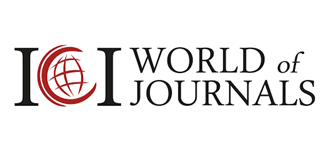Benign Phyllodes Tumor During Pregnancy: 2 Cases Report at the University Hospital of Angre, Abidjan
Cassou Roland Adjoby1*, Ndrin Denis Effoh1, Eléonore Gbary-Lagaud1, Soh Victor Koffi1, Privat Akobe1, Ramata Kouakou Kouraogo1, Zingbe Gondo Soumahoro1 and Brahima Doukoure2
1Department of Gynecology and Obstetrics, University Hospital of Angre, Ivory Coast
2Department of Pathological Anatomy, University Hospital of Cocody, Ivory Coast
Submission:April 10, 2021;Published:April 20, 2021
*Corresponding author:Adjoby Cassou Roland, Department of Gynecology and Obstetrics at the University Hospital of Angre, Ivory Coast
How to cite this article:Cassou R A, Ndrin Denis E, Eléonore G-L, Soh Victor K, Privat A, et al. Benign Phyllodes Tumor During Pregnancy: 2 Cases Report at the University Hospital of Angre, Abidjan. Glob J Reprod Med. 2021; 8(2): 5556734. DOI: 10.19080/GJORM.2021.08.555731.
Abstract
Phyllodes tumors are mammary tumors, consisting of both benign glandular epithelial cells and a proliferation of benign, borderline or malignant conjunctival cells that determine the type and histological grade of the tumor. Phyllode tumor is a rare fibroepithelial neoplasm representing less than 1% of all breast tumors. It occurs in adult women, most often between the ages of 35 and 55. We report 2 cases developed at the expense of the left breast associated with a gravid state, having as characters the rapid growth and the size exceeding the 20 cm of long axis. Based on micro-biopsies that enabled a pre-operative histological diagnosis of benignity, a lumpectomy with safety margins was performed. Histological diagnosis of benign certainty was made on the lumpectomy part, due to the heterogeneity of these tumors. Few cases have been reported during or just after a pregnancy. We followed these two patients, who were able to breastfeed with the right breast and, they did not have a recurrence after 2 years of follow-up.
Keywords:Phyllodes tumor; Benign breast tumor; Fibroadenoma; Pregnancy; Lumpectomy; Histology
Introduction
Breast phyllodes tumors are very rare tumors, accounting for less than 1% of all breast tumors. They are more common in women in genital activity than in postmenopausal women (Peak of frequency between 35 and 55 years). They are fibroepithelial tumors, close to fibroadenomas which represent the main differential diagnosis [1,2]. They are sometimes associated with non-specific signs such as dilatation of the skin veins, retraction of the nipple, skin ulcers, palpable axillary lymphadenopathy, or discoloration of the skin. They are most often benign (60-70%) and are considered a distinct group of neoplasia’s. The malignant forms “sarcomas phyllodes” are part of the primitive sarcomas of the breast [2,3]. The forms associated with pregnancy are very little described, hence the interest of the 2 cases we report.
Observations
Case n°1
We report the observation of a 35-year-old G3P1, with menstruation since the age of 14, which was followed for infertility for 3 years. She had no specific family pathological history. She consulted for a voluminous left breast mass on single progressive pregnancy in the second trimester. The onset of the symptom’s dates to a few months ago when a left breast mass was discovered during a self-examination of the breast. This mass was characterized by rapid growth, motivating consultation. The clinical examination of the breasts made it possible to objectify a voluminous mammary tumor of 22 cm long axis, of firm, painless, hypermobile consistency compared to the cutaneous plane and the deep plane, resulting in deformation of the breast with an orange-peel appearance on the breast surface with hyperpigmentation (Figure 1-3). Examination of the lymph nodes does not find axillary or supra-clavicular lymphadenopathy. The rest of the obstetric and somatic examination found no abnormality. A breast ultrasound was performed objectifying a lobulated hypoechoic mass with internal vascularization. A breast micro biopsy revealed a fibroepithelial lesion in favor of a phyllodes tumour. The patient underwent a large tumor resection, the anatomopathological analysis of which concluded to a grade 1 phyllode tumor (ductal hyperplasia without atypia) (Figure 4). The pregnancy continued normally until the end. The case was discussed in a multidisciplinary meeting, and the decision on exclusive supervision in the post-partum was retained. The patient was able to breastfeed with the right breast and did not relapse after 2 years of follow-up.
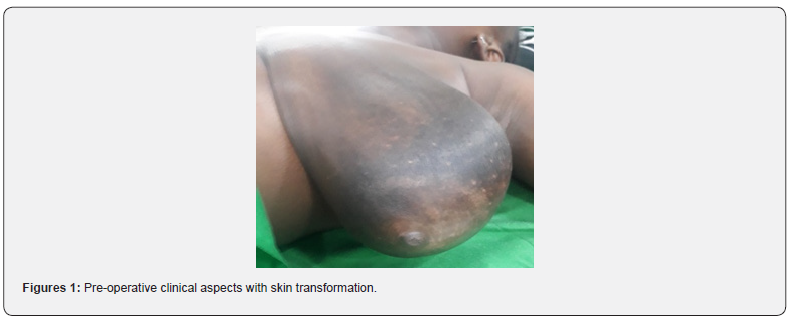
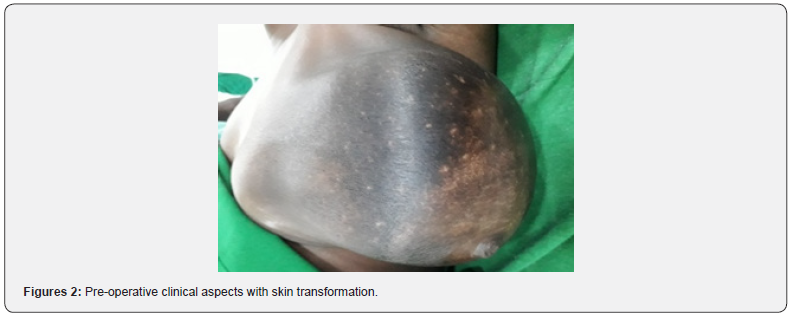
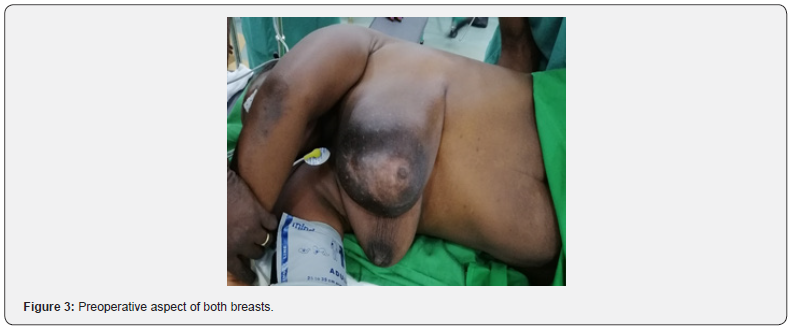
Case n°2
We report the observation of a 21-year-old nulliparous primigravida, puberty since the age of 13, without any personal or family pathological history, who consulted for a mass in the left breast during pregnancy. The onset of symptoms dates to the 6th month of pregnancy with the observation of a rapidly growing left breast mass, prompting a consultation. The clinical examination of the breasts found at the level of the lower quadrants of the left breast, a tumor of 20 cm of long axis, of firm consistency, painless, mobile in relation to the cutaneous plane and to the deep plane, without inflammatory signs or cutaneous lesions in look (Figure 6-8). Examination of the lymph node areas does not find axillary or supraclavicular lymphadenopathy. The rest of the somatic and obstetrical examination was unremarkable. A breast ultrasound was performed objectifying a hypoechoic tumor mass, measuring 20 cm, with regular contours. The diagnosis of an adenofibroma was then retained after a breast micro biopsy. The patient underwent a lumpectomy with excisional margin, the anatomopathological analysis of which concluded in a grade 1 phyllodes tumor (Figure 9 & 10). No adjuvant treatment was indicated, monitoring was carried out to detect a recurrence. The patient was able to breastfeed with the right breast and is in complete remission after 2 years of follow-up.
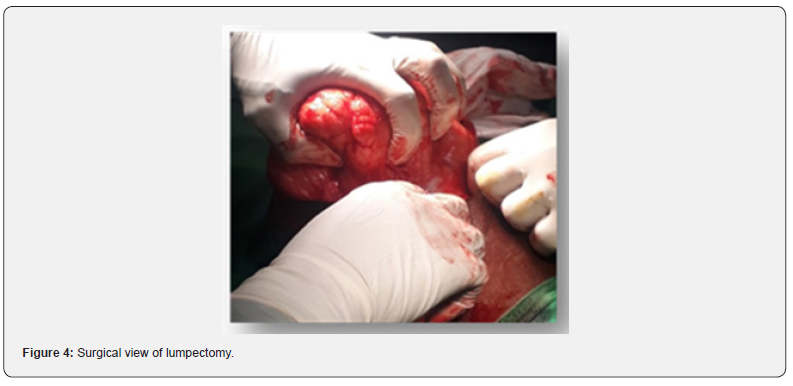
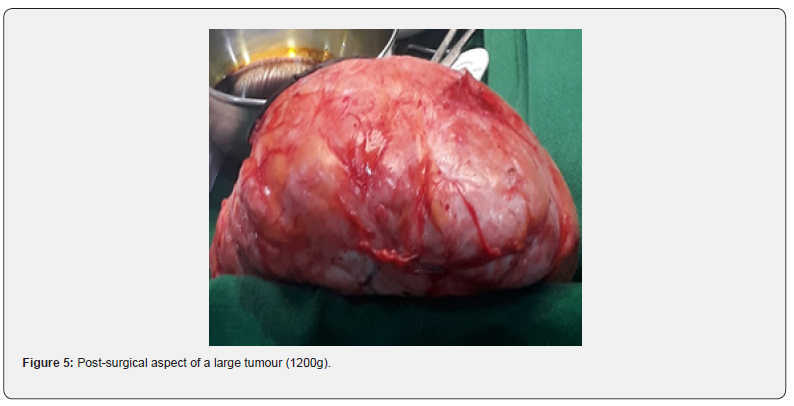
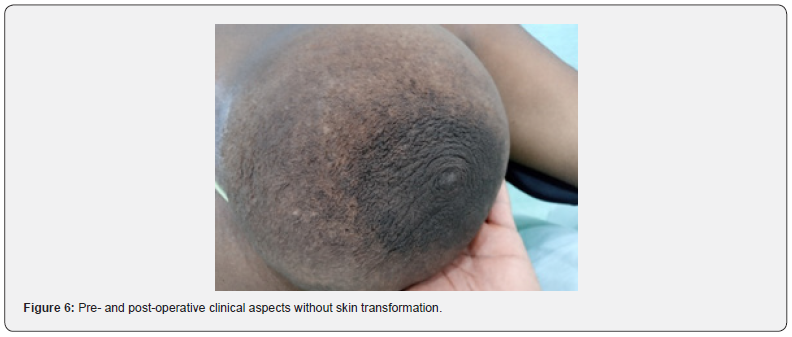
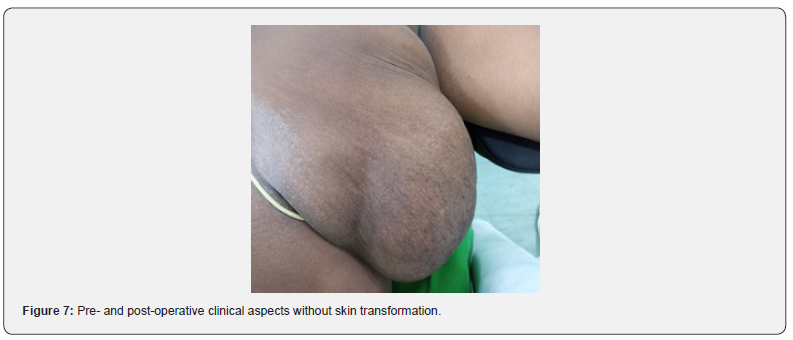
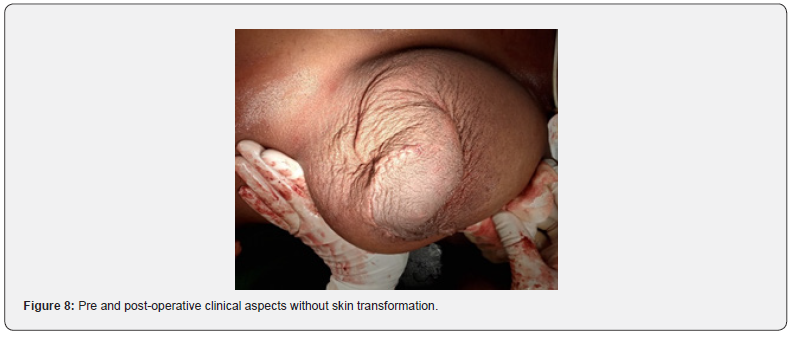
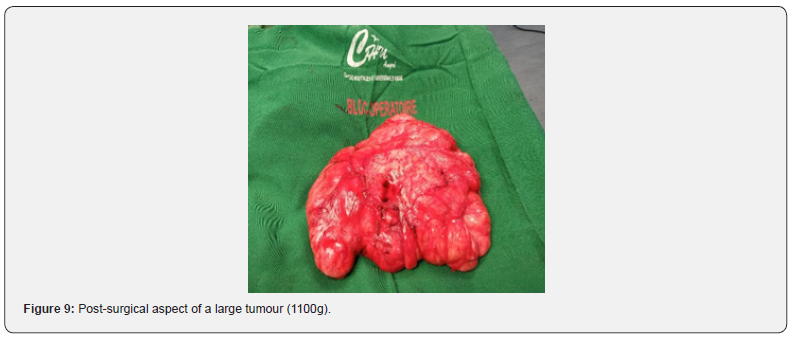
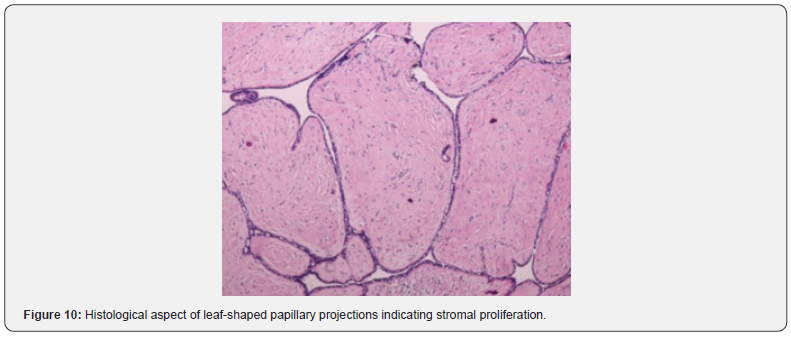
Discussion
Epidemiology
Often benign, phyllodes tumours are rare fibroepithelial stromal tumours of the breast [4,5] They are characterized by the proliferation of epithelial cells and connective tissue cells. They are most often diagnosed during the 4th and 5th decades of life.
Diagnostic
Breast tumors during pregnancy are often diagnosed in advanced stages due to the difficulty in distinguishing pathological changes, physiological changes. However, these tumors can be characterized by a malignant tumor with metastases in 10% of cases [6]. This case study is a presentation of benign phyllodes tumour occurring in pregnant women, very few cases of this association have been described in the literature [7,8]. Clinically, the phyllodes tumor during pregnancy is an extremely fastgrowing tumor causing a characteristic increase in breast volume. It manifests itself as a bulky, firm and elastic mass with a malignant potential [6,9]. In our 2 observations, the masses were unilateral, exceeding the 20cm long axis, which was much higher than the 3.75cm averages observed in the literature [1]. However, the literature finds a bilateral character in 16% of cases [9]. According to Sabban et al. [1], 15% of these tumors exceed 15cm in diameter [1]. The effect of gestational changes in hormone levels on this tumor has not been discussed in the literature, except for several case reports. Large size, rapid growth and bilaterality are often described in the literature [10]. Skin changes such as erythema, dilatation of the subcutaneous veins, stretch marks or inflammatory signs are present only in the case of large tumors as was the case in our first observation [11]. However, phyllodes tumors generally pose a problem of differential diagnosis with fibroadenomas. It is the histological aspect of the connective component that will make it possible to distinguish benign phyllodes tumors, malignant phyllodes tumors (phyllodes sarcomas) and border phyllodes tumors. These tumors must therefore be the subject of a precise preoperative diagnosis, by directed micro biopsy for histology, to provide for the correct surgical management. Ultrasound can show areas of heterogeneous echo structure with cystic anechoic areas [1,8,11]. Magnetic resonance imaging (MRI) when it is possible, also finds the semio logical criteria of a benign tumor. Thus, it does not make it possible to make the differential diagnosis between the phyllodes tumor and the adenofibroma. If macroscopically the benign phyllodes tumor seems well limited, it does not present a pseudo-capsule (consisting of compressive parenchyma) such as the adenofibroma and tends to diffuse into the adipose tissue in the form of small tumor clusters. Recurrence is therefore frequent if surgical excision is not sufficient. Although a few cases of metastases from a benign phyllodes tumor have been reported, they are linked to poor histological classification, probably due to an insufficient number of samples [1,8,10-12]. The histopronostic grade is established on the association of derogatory histological factors, in particular the number of mitoses per 10 fields, the severity of cellular atypias, the tumor / healthy parenchyma interface, the presence of tumor necrosis and stromal density [11].
Course of treatment
In therapeutic terms, surgery is the standard treatment [13]. Enlarged lumpectomy with a safety margin of 10mm is indicated for tumors of grade 1 and 2. And a simple mastectomy without lymph node dissection is indicated for tumors of grade 3, or for tumors larger than 5cm [1,5,6]. Adjuvant radiotherapy finds its place in the case of a grade 3 tumor, a third local recurrence, or a recurrence after a mastectomy [10,11]. Ultimately, phyllodes tumors behave relatively benign. However, we can have a local recurrence in 20 to 35% of cases and metastases appear in 10 to 20% of patients [1,5, 8, 10,12, 14] and after conservative treatment, hence the benefit of prolonged clinical monitoring over at least 5 years.
Conclusion
Phyllodes tumors in the period of gravido-puerperium are very rare clinical situations, it is necessary to think about it in front of a tissue nodule in rapid increase. Our observations testify to the voluminous character that these tumors can take during pregnancy, constituting a great semio logical value in comparison with adenofibromas. In the event of proven benignity, conservative treatment remains a benchmark provided that the tumor is removed extensively, followed by rigorous clinical and radiological monitoring.
References
- Sabban F, Collinet P, Lucot JP, Boman F, Leroy JL, et al. (2005) Tumeurs phyllodes du sein. J gynécol obstet biol rep 34(3): 252-256.
- Mantelet LM, Chauvenet L, Hugol D, Bethoux JP, Gompel A, et al. (2012) Tumeur phyllode maligne du sein et grossesse: à propos d’un cas. In: Cancer du sein: surdiagnostic, surtraitement. Springer, Paris.
- Martino A, Zamparelli M, Santinelli A, Cobellis G, Rossi L, et al. (2001) Unusual Clinical Presentation of a Rare Case of Phyllodes Tumor of the Breast in an Adolescent Girl. Journal of Pediatric Surgery 36(6): 941-943.
- Zhang Y, Kleer CG (2016) Phyllodes Tumor of the Breast Histopathologic Features, Differential Diagnosis, and Molecular/Genetic Updates. Arch Pathol Lab Med 140: 665-671.
- Ogunbiyi S, Perry A, Jakate K, Simpson J, George R (2019) Phyllodes tumour of the breast and margins: How much is enough? Can J Surg 62(1): E19-E21.
- Gentile LF, Gaillard WF, Wallace JA, Spiguel LR, Alizadeh L, et al. (2016) A Case of a Giant Borderline Phyllodes Tumor Early in Pregnancy Treated with Mastectomy and Immediate Breast Reconstruction. Breast J 22 (6): 683-687.
- Liang MI, Ramaswamy B, Patterson CC, McKelvey MT, Gordillo G, et al. (2008) Tumeurs mammaires géantes: prise en charge chirurgicale des tumeurs phyllodes, potentiel de chirurgie reconstructrice et revue de la litté Monde J Surg Oncol 6: 117-121.
- Alipour S (2020) Phyllodes Tumor of the Breast during Pregnancy and Lactation; A Systematic Review. Arch Iran Med 23(7): 488-497.
- Aranda C, Sotelo M, Torres A, Zárate M (2005) Phyllodes tumor and pregnancy. A report of a case Ginecol Obstet Mex 73(7): 387-392.
- Alipour S, Eskandari A (2020) Phyllodes Tumor of the Breast in Pregnancy and Lactation. Adv Exp Med Biol 1252 :137-142.
- Kanouni L, Jalil A, Saâdi I, Sifat H, Hadadi K, et al. (2004) Prise en charge des tumeurs phyllodes du sein à l'Institut national d'oncologie de Rabat, Maroc. Gynécologie Obstétrique & Fertilit (32): 293-301.
- Bendifallah S, Canlorbe G (2016) Prise en charge des tumeurs bénignes du sein épidémiologiquement fréquentes de type adénofibrome, phyllode (grade 1 et 2), et papillome.
- Spitaleri G, Toesca A, Botteri E, Bottiglieri L, Rotmensz N, et al. (2013) Breast phyllodes tumor: A review of literature and a single center retrospective series analysis. Critical Reviews in Oncology/Hematology 88(2): 427-436.
- Kallam AR, Kanumury V, Korumilli RM, Gudeli V, Polavarapu H (2017) Massive benign phyllodes tumour of breast complicating pregnancy. J Clin Diagn Res 11(5): PD08-PD09.









